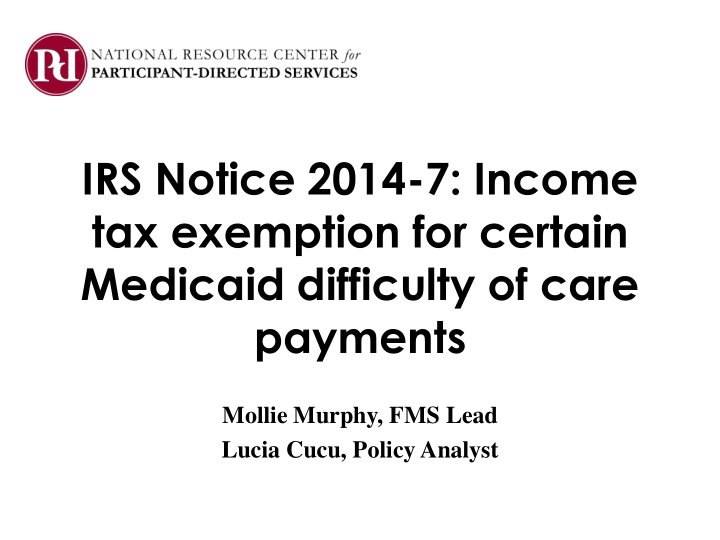



IRS Notice 2014-7: Income tax exemption for certain Medicaid difficulty of care payments Mollie Murphy, FMS Lead Lucia Cucu, Policy Analyst
IRS Notice 2014-7 Issued on January 3, 2014 Difficulty of care payments excludable from income tax under IRC Section 131 if: Paid under a Medicaid waiver program The care recipient and caregiver reside in the same home Does not impact Social Security, Medicare or State Income Tax This came from a different part of the IRS than that which deals with HCSR Was developed in response to advocates from Adult Foster Care provider communities 2
What is a difficulty of care payment? Notice 2014-7: Medicaid waiver payments that “compensate a care provider for providing the additional care required because of an eligible individual’s physical, mental, or emotional handicap for which a state has determined that there is a need for additional compensation” Must be for “nonmedical support services” Also known as: caregiver wages! But only when: Paid under Medicaid When the caregiver and care recipient live together 3
Which payments qualify? “For purposes of this notice, qualified Medicaid waiver payments are payments… made by a state or political subdivision thereof, or an entity that is a certified Medicaid provider under a Medicaid waiver program to an individual care provider for nonmedical support services provided under a plan of care to an eligible individual (whether related or unrelated) living in the individual care provider’s home ” 4
What has changed? Old interpretation of IRC Section 131: Only applies to payments for the care of individuals placed to live in a foster family home Is a care recipient who lives in his own home “placed” to live there and living in a “foster family home”? Can a family member be a foster care provider? Old IRS position: no New IRS position: yes State approval of the Plan of Care equivalent to being “placed” a family home by the state 5
What is the care provider’s home? A family home setting, not an institution For purposes of § 131, “ a person’s ‘home’ is where he resides ” – Notice 2014-7 The care provider does not have to own the building, but must reside in the home 6
Scenario 1 A mother and her son live in the same house The mother owns the house The son provides care to the mother and is paid under a Medicaid waiver program Is this care being provided in the care provider’s (son’s) home? 7
Scenario 2 The son from the previous scenario now moves into a house owned by his wife The mother gifts her house to her son, because she hopes to preserve the tax exemption. So the son now owns the house where his mother lives The son spends weekdays with his mother providing care for her, in the house that he owns. He spends his nights and weekends with his wife and children in his wife’s house Is the care being provided in the caregiver’s (son’s) home? 8
Can someone have more than one home? Department of Labor live-in worker rules: yes A DoL live-in worker must spend at least 5 consecutive days and 4 consecutive nights (or vice versa) per week in the employer’s home Ex: Monday morning to Friday evening IRS difficulty of care exemption: no A worker can only have one residence 9
Scenario 3 Wendy Worker works for Pam Participant. She lives in Pam’s home Monday to Friday, but then goes “home” to spend her weekends in an apartment she maintains where her spouse lives, and where she likes to spend her free time and invite her grandchildren to visit Is Wendy a live-in domestic service worker under Department of Labor rules? Which place is Wendy’s “residence” for purposes of the difficulty of care exemption? 10
Where is home? “We interpret the Code’s use of the word ‘home’ to mean the house where a person regularly performs the routines of his private life --for example, shared meals and holidays with his family, or family time with children or grandchildren ” - Stromme v. Commissioner, 138 T.C. 213 (2012) A worker can be a live-in worker under Department of Labor rules and yet not qualify for the exemption Red flag: caregivers who own or maintain multiple homes Can’t claim the exemption for multiple homes 11
Can the caregiver and care recipient be related? Yes! Under the old rules, the exemption was lost if the caregiver was a family member 12
What about FICA and FUTA? Exemption only applies to federal income tax FICA and FUTA still apply “This notice does not address whether qualified Medicaid waiver payments excluded from income under this notice may be subject to tax under the Federal Insurance Contributions Act (FICA) or the Federal Unemployment Tax Act (FUTA) in certain circumstances” 13
Effective Date January 3, 2014 Can apply for a credit or refund retroactively for taxable years for which the period of limitations has not expired 14
To be discussed with the IRS Are difficulty of care payments still considered wages? How should these payments be reported on a Form W-2? How will the IRS know that it was proper not to withhold income tax? Should employees receiving difficulty of care payments mark Exempt on their W-4 forms? Do payments under government-funded programs other than Medicaid qualify? 15
Questions? How long does a care provider have to live with the care recipient to quality? 16
Recommend
More recommend